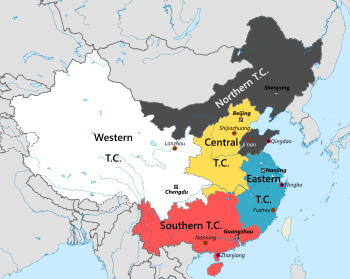Theater commands of the People's Liberation Army
This article possibly contains original research. (April 2016) |

Politics of China |
|---|
 |
|
The People's Liberation Army uses a system of theater commands (Chinese: 战区; pinyin: zhànqū; lit. 'war-region'), of which there are now five:[2]
- Eastern Theater Command with headquarters in Nanjing
- Southern Theater Command with headquarters in Guangzhou
- Western Theater Command with headquarters in Chengdu
- Northern Theater Command with headquarters in Shenyang
- Central Theater Command with headquarters in Beijing
PLA theater commands are responsible for the development of military strategy, tactics, and policy and response to threats or crises within their theater.[2] Theater commands are complex, political, and bureaucratic with a theater commander sharing equal authorities and responsibilities with their assigned political commissar. The theater commander presides over operational matters while the political commissar (who is of equal rank) are responsible for ideological matters.[2] Subordinate to each theater command are single-service headquarters responsible for that service's operations within the theater. During peacetime, these service headquarters have dual chains of command reporting to both national-level service headquarters and to respective theater commands.[2] In wartime, it is likely these theater-level service headquarters will exist under near complete control by the respective theater command.[2]
History[]
The People's Liberation Army was originally organized by military regions. By July 1950, there were the Northwest Military Region, North China Military Region, Northeastern Military Region, Southwest Military Region, East China Military Region, and Central South Military Region.[3]
In December 1954, the existing six major military regions were reorganised into twelve regions: Shenyang (which traces history from the Northeastern Military Region), Beijing, Jinan, Nanjing, Guangzhou, Kunming, , Chengdu, Lanzhou, Tibet, Xinjiang, and .[4] The former Northwest Military Region, which became the Beijing Military Region, doubled as Beijing-Tianjin Garrison Command. Due to the tension in the Taiwan Straits, the State Council ordered the establishment of the on 22 April 1956. It included the provincial military districts of Fujian and Jiangsu, formerly under the Nanjing MR. The Fuzhou MR was officially established on 1 July 1956, with Ye Fei as its commander and political commissar.[5]
The thirteen military regions established by 1956 were reduced to eleven in the late 1960s.[6] In 1967, the Inner Mongolia and Tibet Military Regions were downgraded and incorporated into the Beijing and Chengdu Military Regions.[7]
Those eleven military regions—Shenyang, Beijing, Jinan, Nanjing, Guangzhou (including Hainan Island), Kunming, Wuhan, Chengdu, Lanzhou, Xinjiang, and Fuzhou—were reduced to seven by 1985-88. From that point the active military districts included Lanzhou Military Region, incorporating the former , Chengdu Military Region, incorporating the former Kunming MR, Nanjing Military Region, which includes the former Fuzhou MR, Beijing Military Region, and Shenyang Military Region. Finally Guangzhou and Jinan Military Regions both appear to include parts of the former Wuhan MR.
The military regions are divided into military districts, usually contiguous with provinces, and military sub-districts.[8]
In January 2014, Chinese senior military officers revealed that the PLA is planning to reduce the number of military regions from seven to five "military areas" to have joint command with ground, naval, air, and Second Artillery Corps forces. This change was planned to transition their concept of operations from primarily ground-oriented defense to mobile and coordinated movement of all services and to enhance offensive air and naval capabilities into the East China Sea. The coastal Jinan, Nanjing, and Guangzhou regions became three military areas, each with a joint operations command, for projecting power into the Yellow Sea, East China Sea, and South China Sea. The four other inland military regions were streamlined into two military areas mainly for organizing forces for operations.[9]
In February 2016, the seven military regions were reorganised into five theater commands, as part of the 2015 People's Republic of China military reform.[10]
See also[]
- List of military regions of the National Revolutionary Army, historic former regions
- List of People's Liberation Army Air Force airbases
References[]
Citations[]
- ^ "Archived copy" (PDF). Archived from the original (PDF) on 2016-11-04. Retrieved 2016-08-05.CS1 maint: archived copy as title (link)
- ^ a b c d e "2-10". ATP 7-100.3 Chinese Tactics (PDF). Washington, D.C.: Department of the Army. 2021. ISBN 979-8481060729.
- ^ See Gucheng Li
- ^ Gucheng Li, A Glossary of Political Terms of the People's Republic of China, Chinese University Press, 1995, ISBN 9622016154, 534, citing Record of New China's Military Activities 1949-1959, 379.
- ^ Guacheng Li, 1995, ibid., 534, citing Record of New China, 411
- ^ Chapter 8, PLA Ground Forces, by Dennis J Blasko, in The People's Liberation Army as Organisation, RAND, CF182, 313
- ^ Starr, S. Frederick (2015-03-04). Xinjiang: China's Muslim Borderland. Routledge. p. 130. ISBN 9781317451372.
- ^ Dennis J. Blasko, "PLA Ground Forces: Moving towards a Smaller, More Rapidly Deployable, Modern Combined Arms Force," The PLA as Organization, ed. James C. Mulvenon and Andrew N.D. Yang (Santa Monica, CA: RAND, 2002), 313.
- ^ China plans military reform to enhance its readiness - The-Japan-news.com, 2 January 2014
- ^ "解放军5大战区公布 习近平授军旗(图)_凤凰资讯". News.ifeng.com. Retrieved 2019-04-24.
Sources[]
- Li, Gucheng (1995). A Glossary of Political Terms of the People's Republic of China. Hong Kong: Chinese University Press. p. 534. ISBN 9789622016156.
- Theater commands of the People's Liberation Army
